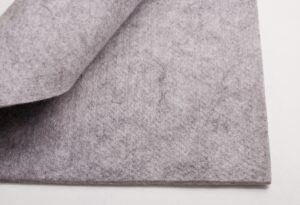Shirts, pants, and blankets come to mind when most people think of textiles. Clothing and blankets are only the tips of the fabric iceberg. Everything from your car’s seatbelt to your office’s desk dividers or acoustic panels to the ubiquitous blue PPE masks that everyone will be wearing in 2020 is made of textiles.
You come into contact with woven or nonwoven fabrics the majority of the time. This method is even used to make the majority of your shirts, although the fibers used are significantly thinner. You could notice a very faint grid pattern on the clothing you are wearing if you look attentively.
But “nonwovens” are a significant component of the fabric that we come into contact with on a daily basis. As the name implies, multilayer felt is created by combining fibers in ways other than weaving, for as by entangling the strands in a needle, using pressure, heat, or wetness to hold them together.
The process of creating a nonwoven felt by needle punching is one of many. This entails taking free strands and forcing them to entangle themselves by “needling” them together using a needle loom filled with barbed needles.
Learn More about- What is Needle Punched? Non-Woven Needle Punched Jute Felt
What Purposes Does Needle Punch Felt Serve?
Needle punch felt serves a variety of purposes outside of craft projects, frequently in more technical ones. Among the most popular applications are:
- Acoustic panels and baffles
- Synthetic soil growing media
- Under-carpet
- High-performance thermal insulation
- Equestrian saddle pads
- Soundproofing
- Filtration
- Vibration isolators
- Mattress pads
- Gasketing
- Padding for vehicle sun visors
- Molded automobile headliners and trunk liners
- Office and desk dividers
Supplies
Although needlepunch embroidery requires certain specific materials, it employs many of the same techniques as surface stitching. Some of them may be available in your neighborhood craft shop, but there are many online vendors who offer everything you want in one location. Punch needle kits provide you all the essentials in one convenient purchase if you want to skip the guessing.
A punch needle tool resembles a standard needle in that it has a metal tip with a hole in it. However, the thread or yarn goes via a channel on this needle. Punch needle tools also include a handle that is comfortable to hold while using them.
To accommodate varying thicknesses, from bulky yarn to embroidery thread, these tools are available in various sizes. The tools are bigger, like the Oxford Punch Needle Tool seen above, while the smaller ones are used for finer stitching and resemble pens.
Even though some of the numerous types of this evenweave cloth are simpler to work with than others, all of them may be used. The size of the cloth weave should correspond to the size of the needle and thread. Use a rougher pattern for thicker threads and a finer weave for thinner ones.
Design:
The first step in creating needle-punched felt is figuring out what the felt will be used for and what qualities it will require. There are very varied requirements for how an engineer would design a product depending on whether the objective is to build a thermal “heat shield,” beneath carpet padding, or a filter that will remove COVID19 particles from a home filtration system.
This procedure starts with choosing the fiber for any kind of nonwoven, including needle punch felt. In order to increase the capabilities of the completed felt, multiple fibers may be blended in varying proportions. Each fiber has unique properties that can help it meet a variety of needs.
In order to produce the best product for the final customer, various parameters like weight per square yard, thickness, surface texture, and many other things must be decided.
Construction:
Following completion of all design engineering calculations, enormous bales of loose fiber are used to begin the felt’s manufacture. Both synthetic and organic fibers, such as wool, cotton, and alpaca, can be used to make these materials. Synthetic fibers include polyester, nylon, acrylic, rayon, and fiberglass.
The fiber bales must next be placed into devices known as bale breakers. These devices separate the tightly packed fiber bale so that it may be processed more easily.
In order to get the desired result, various fiber kinds are frequently combined while making felt. In order to obtain the proper percentage of the mix, the fiber that is transferred from the bale breakers to the next stage of the process is meticulously weighed before being blended and carded.
During the carding process, the fiber is broken up and mixed. Loose fiber beds are fed onto huge wired rollers during the carding process. This wire works to separate each fiber strand, combine and blend the constituent parts, and orient the fiber in a single direction.
The fiber flows from the carding device as a web. This webbing has a cotton candy-like substance and is comparable to the phony spider webs you see around Halloween. For the first time, the fiber resembles a cloth, however, like cotton candy, this substance has very little strength.
This webbing is placed onto a conveyor, which transports it to a cross-lapper. Each small layer of webbing is folded over itself by the lapper, giving the finished felt thickness and weight. The intended thickness and weight of the completed product influence the number of layers.
The webbing layers enter the needle loom after the lapper. The name “needle punch felt” derives from this.
The multilayer web of fiber is punctured by a needle loom, a precision device that employs barbed needles set on a needle board. 600–2,000 punches per minute are made on the fibers by the needle boards. By repeatedly pounding the needles, the fibers become entangled and form a solid link.
For certain felts, the felt-making process ends here. Others, however, undergo extra needling, more felt layers to increase density, heat treating, calendaring, singeing, and lamination as finishing procedures. Other materials, such as foam, rubber, or other materials, are sometimes added to some felts to create composite layers. Here is a little video of an “off-line” needle loom that is further tangled up in a felt object.
Conclusion
Needlepunch is still used everywhere and it is made from jute and B.J. Geotextiles is the best jute product manufacturer u can ever find.


